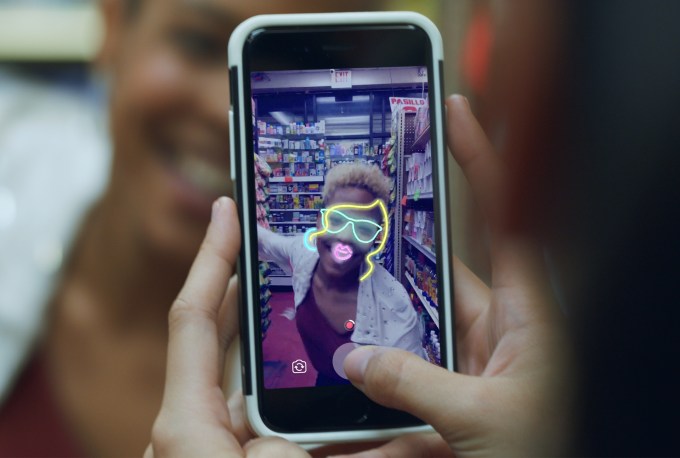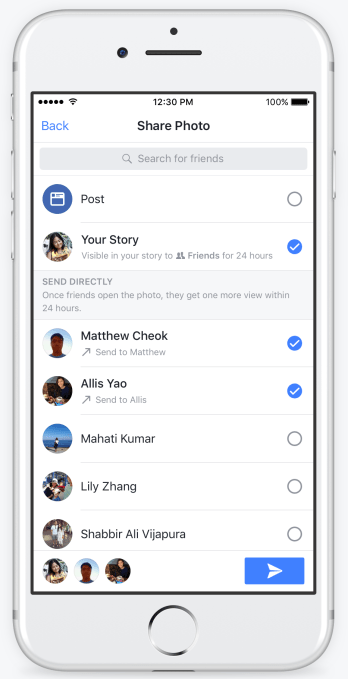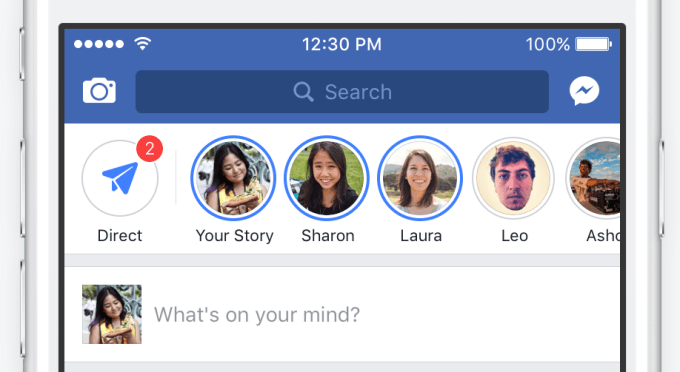In its biggest change in a decade, Facebook is evolving from text and link-focused sharing to the visual communication format it admits “Snapchat has really pioneered.”
Starting today, all users will soon have access to the new Facebook Camera feature that lets them overlay special effects on photos and videos. They can then share this content to a Snapchat clone called Facebook Stories that appears above News Feed on mobile and works similarly to Instagram’s 24-hour ephemeral slideshows. Users also may share these posts to News Feed, individual friends through the new Facebook Direct private visual messages that disappear once digested or any combination thereof.
“As people mostly post photos and videos, Stories is the way they’re going to want to do it,” says Facebook Camera product manager Connor Hayes, noting Facebook’s shift away from text status updates after 10 years as its primary sharing option. “Obviously we’ve seen this doing very well in other apps. Snapchat has really pioneered this,” explained Hayes, less shy to mention the competitor by name than some other Facebook executives.
But really it was the rapid ascent of Instagram Stories to 150 million daily users that he says inspired Facebook to start testing its own Stories in January, and keep expanding it to 12 countries before today’s rollout. Surprisingly, Hayes says Facebook Stories is “additive,” not detracting from News Feed sharing or usage of its other Stories products. “We’ve tested in markets with Instagram Stories and Messenger Day, and we’ve seen this as accretive. They end up posting more and they like using the Stories format across apps.”
That’s the worst news for Snapchat and best news for Facebook since the world’s biggest social network adopted the strategy of copying the competitor that refused its acquisition offer.
If Facebook Stories clearly cannibalized News Feed sharing and consumption, it would have to demolish its most popular and lucrative feature to make way for the future where the camera is the new keyboard. And if users saw Facebook, Instagram, Messenger and WhatsApp’s Stories features as uncool clones or redundant as a set, it might have had to limit its attack on Snapchat to just one of its core apps.
Instead, Facebook can charge in full-speed, attacking Snap from every angle without much penalty to its existing business. And with its enormous engineering and design teams, plus billions in profit each quarter, it can throw more resources at Camera, Stories and Direct visual messaging than Snap can. That product development strength is on display with today’s launch, and apparent from Facebook’s insistence on showing reporters forthcoming special effects that one-up Snapchat’s iconic lenses.
Until now, Facebook was just running missile tests and fighting skirmishes on the frontier. Today Facebook declares total war on Snapchat.
Storytelling for everyone
“The way people have been prompted to share for 10 years, it’s very text-centric,” Hayes describes. “Even when you look at the way we’ve done this on mobile, you can see half of the screen is still taken up by a place for you to type text.”
“Our new camera puts visual content at the heart of the Facebook experience,” says Kristen Spilman, Facebook’s director of art and animation. “So it feels natural for the camera to do more of the talking.”
Facebook has been casually pursuing visual communication for years, but got serious about it back in August when it started testing the first version of Facebook Camera during the 2016 Olympics. It went so far as to replace half the News Feed home screen with an open camera window. But while Snapchat opens straight to the camera, Spilman says “people were not comfortable with how drastic some of the change was.” It can be pretty jarring to suddenly see your own face on screen, so Facebook decided to hide the camera but let you open it with a swipe. Hayes says Facebook would consider opening to the camera “if over time we find this becomes the primary use case.”

Facebook wants to make Camera and Stories accessible to the wide range of demographics that use it everyday, not just the teens that gravitate to Snapchat. “We learned from Instagram that Stories as a format is actually great for all types of people,” says Hayes. “We think it’s going to be adopted by people regardless of age.”
Courting the international market was also a priority for Facebook. It’s built text-overlay filters using local slang for around 10 different top markets, like the U.S. and Canada. In Ireland, users can slap the words “Gas” or “Some Craic” on their posts, which might confuse those abroad but mean “astonishing” and “having a good time” in the country.
This is how Facebook plans to recruit users to Stories that Snapchat has forgotten. While the LA startup has focused almost entirely on U.S. teens, Facebook designed its version to appeal to teens everywhere and be intuitive enough for older users that Snap shunned with its esoteric interface.
How to use Facebook Stories, Camera and Direct
Facebook’s obvious but somewhat cluttered design puts its new products readily accessible from the home screen rather than buried in tabs.
Stories
Just like with Instagram Stories, you’ll immediately notice the circular Stories bubbles in a row above the News Feed, showing the profile pics of friends who’ve posted, ranked by relevancy rather than reverse chronology like Snapchat. This solves the problem that you didn’t necessarily add all your friends to see their Stories. Even though your boss or distant acquaintances might post, you’ll see your closest friends first, which makes sure you get the maximum value no matter how long you spend watching.
 One big problem with Facebook Stories is that they’re visible to all your friends and for now you can’t change that. That interferes with the more casual, off-the-cuff, goofy, personal style of content people typically post to Stories, which they might not want their boss or family to see. Facebook should build a privacy feature for hiding your Story from certain people. At least you won’t see Stories from anyone you unfollowed on Facebook, like annoying old buddies or exes you want to avoid.
One big problem with Facebook Stories is that they’re visible to all your friends and for now you can’t change that. That interferes with the more casual, off-the-cuff, goofy, personal style of content people typically post to Stories, which they might not want their boss or family to see. Facebook should build a privacy feature for hiding your Story from certain people. At least you won’t see Stories from anyone you unfollowed on Facebook, like annoying old buddies or exes you want to avoid.
As you watch the chronological slideshows of photos and videos you can tap to fast-forward a frame or swipe to skip to the next friend, each of which can see who watched their Story in what order. Relevancy-sorting also empowers auto-advance so all your friends’ Stories play in a row, unlike Snapchat, which makes you clumsily create a manual playlist of which to watch.
A text and image reply bar appears overlaid on Stories so you can quickly type or shoot a response that gets sent over Direct. These replies only live as long as the 24-hour disappearing content, so friends will have to check them quickly or miss them entirely. The readily visible reply bar might slightly obstruct the view, but should greatly increase reply frequency.
For now, Facebook Stories can’t be viewed by your public followers, so the product is effectively pushing social media influencers to do their broadcasting on Instagram Stories where verified profiles get special features. There’s also no Pages or businesses allowed on Stories for now, or ads inserted between Stories. However, Spilman says once Facebook is sure users love Stories, “We’ll considering broadening to brands and businesses.” Injecting ads could give Facebook a new supply of ad inventory just as it expects to run out of News Feed ad space — something that’s worried Wall Street in recent earnings reports.
Camera
A quick swipe right from the feed reveals the Facebook Camera, where you can tap to shoot a photo or hold to record video. After you jazz it up to your liking, you can either post to your Story, to the News Feed, to specific friends via Direct or any mix of these. The option to blast a Camera post to all of them could be spammy, but sometimes you might want to share the best scene from your Story to News Feed. Facebook even encourages Camera posts to News Feed by making them full-bleed thanks to overlaid profile pics and Like/comment buttons.
Along with shooting new stuff, you can upload from your camera roll with no restrictions or borders on old content. You’ll only see letter boxing if content was shot on a device with a different aspect ratio. Videos have a max length of 40 seconds, much longer than Snapchat’s 10 and Instagram’s 15. That means you can share longer videos you’ve recorded or downloaded, like viral clips.
Facebook’s Camera offers most of the creative tools you’d expect, plus a lot more.
 What’s in Facebook Camera:
What’s in Facebook Camera:
- Drawing with resizable marker and chalk brushes
- Emoji stickers
- Colored captions
- Animated selfie lenses and masks
- Environmental effects like highlight lines and funhouse mirrors
- Reactive filters that respond to movement like lava lamp colors
- Iterative filters that surprise you with new effects if you get more people in frame
- Fine-art-style transfers that make your images look like line drawings or impressionist paintings
- Professional artist filters like Hattie Stewart’s doodle bombs and Doug Copeland’s psychedelia
- Licensed filters from six movie studios, including a Minions filter
- Cause-supporting filters like rainbows for gay pride
- Geotagged location filters for certain places
- Country-specific filters for around 10 initial markets
What’s missing:
- Simple Instagram-style color filters for boosting exposure or contrast (Snapchat, Instagram)
- 3D stickers for pinning text, emoji or drawings to objects in a video (Snapchat)
- Playback effects for slow-mo and fast-forward (Snapchat)
- FaceSwap (Snapchat)
- User- and business-submitted filters (Snapchat)
- Caption background colors for easy reading (Instagram)
- Location tags for turning any place-name into a stylized sticker (Instagram)
- Mentions for tagging friends (Instagram)
- Computer-generated filters that turn any text into frames (Messenger)
- Who’s Up For? filters for inviting friends to hang out (Messenger)
Rather than hiding special effects behind an unintuitive tap like Snapchat, a column of dots denotes that you can vertically swipe through suggested special effects like ones for a current holiday or your city. There’s also a whole tray of 50 to 70 categorized effects showing the most popular ones, those you’ve recently used, selfie masks, style and color filters and overlaid illustration frames.
 Facebook refused to detail any financial details of its licensed filters like the Minions movie effect. It could try to pull sponsorship revenue from these like Snapchat, or just curate ones people will actually want and offer them free like Facebook already does with branded stickers.
Facebook refused to detail any financial details of its licensed filters like the Minions movie effect. It could try to pull sponsorship revenue from these like Snapchat, or just curate ones people will actually want and offer them free like Facebook already does with branded stickers.
When Facebook gathered reporters in San Francisco yesterday to demo the product, it clearly wanted us to think of it as going a step beyond Snapchat’s offering. That’s why it showed off high-tech effects that aren’t available yet. One, for example, adds Mario-esque music and throws 8-bit sunglasses on each additional person who comes into frame, with a bonus effect if you can get five people on camera together.
The next big opportunity here for Facebook is turning Camera into a platform. As I wrote last year, Facebook can’t possibly dream up every possible special effect people might want. Snapchat already allows filter submissions and payments in exchange for temporary geoflters. By allowing users and AR developers to submit filters. Facebook could make its camera’s breadth infinite. Though Facebook was cagey, the team admitted “that is a long-term vision for the platform.”
Overall, Facebook Camera feels extremely powerful and polished, with effects popping up fast and a sensible way of organizing them all. It doesn’t require you to know secret tricks or techniques, which can be fun for the teen in-crowd but alienating to olds. Whether or not you use Stories, Facebook Camera should help you express yourself more vividly.
Direct
While Facebook split off chat from its main app a few years ago and forced people to download Messenger, Direct brings private communication back to the main app. Anything you shoot or upload through Facebook Camera can be sent to specific friends who’ll receive it in their Facebook app’s Direct inbox. You just can’t start with a text. These messages last at least until they’re viewed, and will remain visible until the conversation stops. So if you’re rapidly replying back and forth with text or images about a Direct message it will stay alive, but it goes away once you cease to banter.

Facebook tells me after content disappears from your Story or Direct messages, it completely deletes the content off its servers. The only exception is if it’s flagged by someone for violating Facebook’s community standards, in which case it’s kept until the investigation concludes. Though it might seem a bit redundant with Messenger also having its own camera, Hayes says “it’s not out intention to build up Direct as a Messenger replacement.”
The new News Feed
Whenever you move 1.8 billion people’s furniture, some are going to get pissed. Loyal Snapchat users or those whose friends primarily live on Instagram might see Stories as making Facebook too cluttered, bloated or redundant. But there are still at least a billion people who would probably enjoy Stories that aren’t using them every day yet. These are Facebook’s core targets with today’s launches.
Now people have Stories for each way they might want to share. Instagram Stories is for artful photography. Messenger Day is for igniting conversations and inviting friends to hang out. WhatsApp Status is for minimalist visual communication. And Facebook Stories is for showing your day-to-day life to the widest audience. Though subtle, those differences are likely why Facebook doesn’t offer any cross-posting options, making creators do the labor of re-uploading everywhere if they want to reach all their networks.

Don’t expect Stories in Facebook’s apps to suddenly stamp out Snapchat. Facebook’s best hope is that U.S. teens who are addicted to Snapchat end up using its Stories too. But Snapchat’s neglect of international markets and older age demographics left the door open for Facebook. Now with its aggressive invasion of the Stories space, it may claim those segments before Snapchat ever gets a chance, blocking the upstart’s growth.
In the long-run, we remember the tech companies that provide value at scale, not just who invented things. We remember Netscape as an innovator, but that doesn’t make Google Chrome a clone. Facebook was willing to swallow its pride to protect its future. Maybe if Yahoo or BlackBerry were willing to pivot like this, they’d still be in power.






























Comment